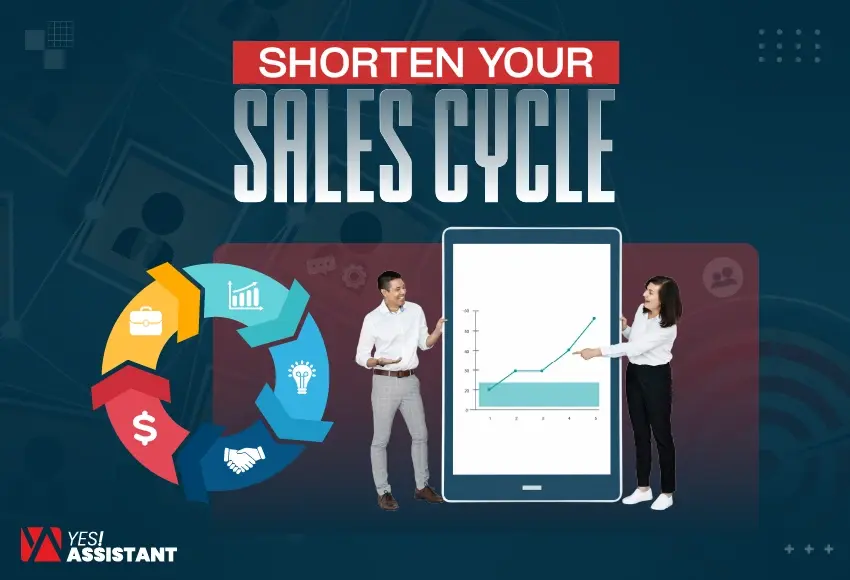
7 Strategies to Shorten Your Sales Cycle – Top Picks
Imagine you’re closing a sales cycle with an excellent rate, which is hitting your monthly target, connecting to your core objective. A well-optimized sales cycle is a repeating sequence of stages designed to transform your prospect into a customer. If you don’t have a strategy, you’re like navigating a sales cycle without a plan.
Developing an effective strategy to craft content can empower your reps and accelerate decision-making. Therefore, aligning your marketing and sales teams is essential for a consistent customer journey. In this blog, you’ll learn strategies for addressing objections proactively, streamlining the decision-making process for your clients, and the impact of time-based offers.
What's Inside
- What Is a Sales Cycle?
- How to Shorten Your Sales Cycle?
- Final Words
What Is a Sales Cycle?
A sales cycle is the process of collecting and nurturing repetitive prospects through sequential stages. Moreover, the follow-up process reinforces converting a prospect into a paying customer. The sales cycle consists of multiple stages that facilitate the sales process, where salespeople identify potential customers through several methods. The prospecting method includes networking, referrals, and online research.
The goal of a sales cycle is to ensure sales reps understand customer needs and research, and can then map them to product solutions.. Mastering the following steps is essential to developing a truly structured and efficient sales cycle.
How to Shorten Your Sales Cycle?
Reducing your sales cycle includes rushing projects, optimizing efficiency, and improving communication. Therefore, enhance your communication and deliver value at every touchpoint. See how you can make the sales engine shorter and faster:

1. Automate Repetitive Tasks
Manual but repetitive tasks waste essential time that drags down sales reps and extends the sales cycle. Optimizing automation tasks, your team is available to focus on high-value activities like engaging with prospects and closing deals.
CRM Automation
CRM systems help automatically log into emails, calls, data entry, task reminders, and meetings. This ensures no leads are missed, and customer interactions are input without effort.
Follow-up email sequences
Instead of crafting individual follow-up emails — set up group automated reminders for follow-up, setting deadlines, or internal team meetings. These sequences ensure consistent communication and nurture leads with no gaps.
Proposal generation tools
Creating customized proposals can be time-consuming. Use proposal generation tools to automate your group proposals, ensuring accuracy and a professional presentation in a fraction of the time.
| Pro Tip: Integrate your CRM with HubSpot, Salesforce platforms. For email sequencing use – Salesloft, Reply.io. And, for Proposal tools, utilize PandaDoc and Proposify tools to automate lead nurturing and accelerate deal closures within a few steps. |
2. Improve Lead Qualification Early
One of the most common reasons for wasting time on unqualified leads directly prolongs your sales cycle. Therefore, pursue your prospects who lack the budget, authority, need, or timeline. This solution is guaranteed to lead to wasted effort and slow deals.
Ideal Customer Profile (ICP):
Develop a detailed ideal customer profile that outlines characteristics of your most successful customers. An ideal customer profile is a detailed description of the type of customer willing to get value from your products or services. Furthermore, without identifying a clear ICP, your sales team will waste valuable time nurturing leads.
You must use rich data analysis to ensure your sales cycle gets off to a productive start and gets high-value prospects. ICP sales help you to identify precise ICPs and develop a strategy to target them effectively.
| Pro Tip: Use ICP-building platforms ( like Clearbit, Cognism) and lead scoring tools (example, HubSpot, Salesforce) to precisely define and prioritize your ideal customers by analyzing firmographic, technographic, and behavioral data. |
Bant/Champ/Gpctba/C&I Frameworks
Use an established sales qualification framework like the BANT model (Budget, Authority, Need, Timing). Also, you can use GPCTBA/C&I (Goals, Plans, Challenge, Timeline, Budget, Authority/ Consequences & Implications) targeting the right prospect. This framework will provide you with a structured approach to assessing lead viability.
3. Use Sales Enablement Content
Organize your sales team by providing right tools and information so that they can answer your customers’ questions. Your sales team should be confident enough at every stage of the buyer’s journey to address their concerns. A well-crafted sales content can significantly accelerate your decision-making.
Case Studies, Pricing Sheets, Demo Videos
Provide engaging case studies showcasing your customer success with clear and concise pricing sheets and engaging demo videos. This focuses on your product value without additionally requiring any live registration.
- Case studies are powerful tools highlighting your present customers’ achievements, with measurable success, through using your product or services. This is social proof and related scenarios helping prospects to demonstrate business success.
- Providing clear pricing information prevents unnecessary reciprocal communication and confusion about costs. Through different packages or customized pricing options, you can optimize your proposal.
- Also, showcase your pre-recorded, high-quality demo videos that attract your prospects to find your solutions at their own pace. This is an excellent initiative to follow up on resources and accelerate features and benefits with an additional live meeting.
FAQ and Competitor Comparison Sheets
Research on your relevant prospects’ common queries and objections regarding comprehensive FAQs. Thereon, develop a detailed competitor comparison sheet to help reps articulate your unique selling propositions and track competitive approaches effectively.
- A comprehensive FAQ document openly accessible on your website typically answers many common questions. This saves your time during calls and references the information gathering phase for your prospect.
- These documents equip your sales team with clear, concise, and accurate information on how your solutions compare to your key competitors.
4. Align Sales and Marketing Teams
A disconnected relationship between sales and marketing leads to misqualified leads, resulting in a waste of time & effort. Consistent collaboration between two teams approach to attracting, nurturing, and converting prospects. Furthermore, a sales virtual assistant from a remote location can contribute to aligning two groups for your operation excellence.
Build a shared Key Performance Indication (KPIs) and a consistent lead scoring system to ensure both teams are working towards the same goals.
- Make sure your sales and marketing follow a unique strategy, like qualified lead generation, conversion rates at every stage, and revenue generation. For example, when generating simple leads, you can invest in both quality leads and conversion. You can hire a remote assistant who can connect sales and marketing with a similar strategy.
- Implement a transparent and jointly decided lead scoring system. Marketing assigns scores to leads based on their demographic information, like job title, company size, and matching with the ICP. Also, check engagement content that ensures a ready-to-sales conversion, and reduce time spent on low-quality leads.
Unified Messaging and Content Strategy
Design a consistent outreach and content strategy that aligns with both sales and marketing strategies, ensuring your brand voice and a clear value proposition.
- Let’s make sure your sales message is easy for everyone. Delivering with a value proposition and brand story is communicated by marketing consistently. Inconsistent messaging results in your prospects’ confusion, disintegrates trust, and forces them to re-evaluate their understanding of your offerings.
- Working together on where your content is delivered. Aiming your sales on the front lines, and valuable insights into prospects with common objections. Marketing can customize the direct feedback to create highly relevant content that addresses issues proactively and accelerates the buyer’s journey.
5. Address Objections Early
Proactively addressing and resolving issues can help you grow your sales by consistently moving.
Anticipate And Script Responses
Just identify common objections and develop well-crafted, confident responses to address your prospects effectively. Sales reps should be trained and equipped with these scripts to handle objections smoothly and effectively.
- Through analyzing conversions with sales reps and customer feedback, combine a list of the most frequent objections. The objects like, “We already use X solution,” “We don’t have the budget,” “It’s not the right time now.”
- For every objection, craft well-organized and persuasive responses. These should be clear and concise scripts rather than guidelines to equip sales. So, you need to focus on recrafting the objection, clarifying the misunderstanding, or showcasing your unique value.
Use Trust Signals Like Testimonials And Reviews
Reinforce your social proof to build credibility with your audiences. Also, combine your previous project testimonials, reviews, and case studies into sales conversions and materials to demonstrate proven success.
- Using short, impactful statements from your previous customers that speak to specific benefits you can provide to the customers. These can be used verbally by reps, include proposals, or feature on your website.
- Optimize third-party review platforms that directly recognize you to your clients, providing accurate reviews from your clients. Here, your prospects can see trusted feedback from platforms like G2, GoodFirms, Google Reviews, Trustpilot, and Glassdoor.
| For Example: “According to HubSpot’s 2024 State of Marketing Report, 61% of marketers say improving SEO is their top inbound marketing priority.” |
6. Streamline the Decision-Making Process
In B2B sales, the decision-making process involves multiple stakeholders, even with different departments regarding prioritization. An accelerated decision process is a major contributor to exceeding sales cycles. You can significantly reinforce it:
Identify All Stakeholders Early
Considering B2B sales, multiple individuals are often involved with the buying decision. Thus, it’s very much essential to identify those stakeholders early in the process to ensure you’re properly addressing the concerns and requirements.
Offer Self-Service Options Or Instant Demos
Empower prospects to find solutions to match your prospects’ unique needs. Also, provide self-service portals, interactive product tours, or instant demo access to speed up their understanding and evaluation.
7. Use Time-Based Offers and Incentives
Although earlier approaches showcased your efficiency and qualification, time-based offers and incentives directly address procrastination. Therefore, you can provide an acceptable reason for the prospect to act now. This strategy can be a powerful accelerator at the negotiation and closing stages.
Create Urgency With Limited-Time Discounts or Bonuses
To attract your prospect, offer different discount packages with these steps:
- Offer a limited-time discount, fixed discount, or reduced fee for a short.
Example: “Sign within this week, and get 30% off.”
- Again, instead of price reduction, offer added value that expires soon. Also, provide additional value for purchases made within a specific time frame
Example: “Buy now and get a free bonus within 72 Hours.”
- Offer early or exclusive features or products for a limited time. This is an offer included in “Exclusive offers.
Example: “Be among the first to try our new feature! Available for the next 14 days only.”
Final Words
A shortening sales cycle isn’t just about closing faster; it’s about optimizing your comprehensive sales operation for maximum efficiency and profitability. Implementing these strategies, from task automation, improves lead qualification through optimizing engaging content and creating urgency. You can transform your sales process into fine-tuning for optimal revenue generation.
Every day you save in your sales cycle is also achieving momentum, revenue, and building trust. As you wait every day to fix up cracks in your sales cycle, another deal is lost to delays, disinterest, and indecision.




